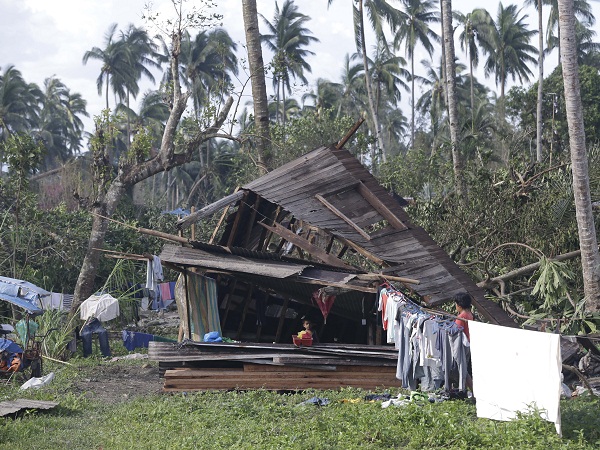About 350 die in Philippine typhoon, 400 missing

A resident dries their clothes amidst their toppled house at the flash flood-hit village of Andap, New Bataan township, Compostela Valley in southern Philippines Wednesday Dec. 5, 2012. Typhoon Bopha, one of the strongest typhoons to hit the Philippines this year, barreled across the country’s south on Tuesday, killing scores of people while triggering landslides, flooding and cutting off power in two entire provinces. AP/Bullit Marquez
NEW BATAAN, Philippines — Stunned parents searching for missing children examined a row of mud-stained bodies covered with banana leaves while survivors dried their soaked belongings on roadsides as the death toll from the southern Philippines’ powerful typhoon climbed to about 350 people Thursday with nearly 400 missing.
The Office of Civil Defense reported that more bodies were retrieved from hardest-hit Compostela Valley and Davao Oriental as well as six other provinces.
At least 200 of the victims died in Compostela Valley alone when Typhoon Bopha struck Tuesday, including 78 villagers and soldiers who perished in a flash flood that swamped two emergency shelters and a military camp.
“Entire families may have been washed away,” said Interior Secretary Mar Roxas, who visited New Bataan on Wednesday.
The farming town of 45,000 people was a muddy wasteland of collapsed houses and coconut and banana trees felled by Bopha’s ferocious winds.
Article continues after this advertisementBodies of victims were laid on the ground for viewing by people searching for missing relatives. Some were badly mangled after being dragged by raging floodwaters over rocks and other debris. A man sprayed insecticide on the remains to keep away swarms of flies.
Article continues after this advertisementA father wept when he found the body of his child after lifting a plastic cover. A mother, meanwhile, went away in tears, unable to find her missing children. “I have three children,” she said repeatedly, flashing three fingers before a TV cameraman.
Two men carried the mud-caked body of an unidentified girl that was covered with coconut leaves on a makeshift stretcher made from a blanket and wooden poles.
Dionisia Requinto, 43, felt lucky to have survived with her husband and their eight children after swirling flood waters surrounded their home. She said they escaped and made their way up a hill to safety, bracing themselves against boulders and fallen trees as they climbed.
“The water rose so fast,” she told The Associated Press. “It was horrible. I thought it was going to be our end.”
In nearby Davao Oriental, the coastal province first struck by the typhoon as it blew from the Pacific Ocean, at least 115 people perished, mostly in three towns so battered that it was hard to find any buildings with roofs remaining, provincial officer Freddie Bendulo and other officials said.
“We had a problem where to take the evacuees. All the evacuation centers have lost their roofs,” Davao Oriental Gov. Corazon Malanyaon said.
The International Federation of Red Cross and Red Crescent Societies issued an urgent appeal for $4.8 million to help people directly affected by the typhoon.
The sun shined brightly for most of the day Wednesday, prompting residents to lay their soaked clothes, books and other belongings out on roadsides to dry and revealing the extent of the damage to farmland. Thousands of banana trees in one Compostela Valley plantation were toppled by the wind, the young bananas still wrapped in blue plastic covers.
But as night fell, however, rain started pouring again over New Bataan, triggering panic among some residents who feared a repeat of the previous day’s flash floods. Some carried whatever belongings they could as they hurried to nearby towns or higher ground.
After slamming into Davao Oriental and Compostela Valley, Bopha roared quickly across the southern Mindanao and central regions, knocking out power in two entire provinces, triggering landslides and leaving houses and plantations damaged. More than 170,000 fled to evacuation centers.
On Thursday, the typhoon was over the South China Sea west of Palawan province. It was blowing northwestward and could be headed to Vietnam or southern China, according to government forecasters.
The deaths came despite efforts by President Benigno Aquino III’s government to force residents out of high-risk communities as the typhoon approached.
Some 20 typhoons and storms lash the northern and central Philippines each year, but they rarely hit the vast southern Mindanao region where sprawling export banana plantations have been planted over the decades because it seldom experiences strong winds that could blow down the trees.
A rare storm in the south last December killed more than 1,200 people and left many more homeless.
The United States extended its condolences and offered to help its Asian ally deal with the typhoon’s devastation. It praised government efforts to minimize the deaths and damage.